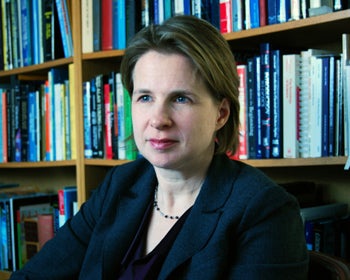Climate modeling and the media
Mar 2, 2011 - by Staff
Mar 2, 2011 - by Staff
11 March 2011 • Weather and climate communication was the theme of the 2010 annual meeting of the American Meteorological Society. Among those addressing the topic at the meeting was Karen Akerlof, a GMU doctoral student in environmental science and public policy. Akerlof has analyzed the treatment of climate modeling in the mass media, including four national newspapers (the Wall Street Journal, Washington Post, New York Times, and USA TODAY). As she sees it, models are a missing piece in climate change journalism.
How have newspapers been covering climate modeling?
Very few articles even mention it. In the last 13 years, only 11 journalists accounted for almost half of the non-opinion coverage of modeling in the four newspapers I studied. The fraction of climate change articles that mentioned modeling dropped from around 4.5% to less than 2.5%. Another trend that’s worrisome is that, as newspapers have downsized, they’ve gotten rid of a lot of their science reporters. It takes experience and familiarity in order to put modeling into a story, yet we’re losing the people who do it best.

You found that radio programs such as “The Rush Limbaugh Show” and NPR’s “Science Friday” provided some of the most frequent coverage of climate modeling. Why might that be?
Both of these programs have a fair amount of air time. They approach climate models in different ways. “Science Friday” is more of a traditional science journalism outlet. On the other hand, you have a political commentator in Rush Limbaugh, which speaks to the politicization of the dialogue around climate change.
How does newspaper opinion fit into the picture?
In three of the newspapers I studied, about 20% of the modeling coverage appeared in opinion sections, but in the Wall Street Journal, the figure was 54%. It’s an interesting dynamic and very different from the other publications. Most of the time when media content is analyzed, people are only looking at news. I was interested not only in news and features but whether modeling showed up in commentaries, editorials, or letters to the editor. In the end, readers get the entire newspaper as a whole.
What are the larger implications of your work?
Kevin Trenberth [NCAR] thinks there’s a good chance of increased uncertainties in the next IPCC report, even though the models are actually better. He points out that this is going to be very difficult for the public to understand. We’re already at the point in climate change where we have knee-jerk reactions. Having a little more nuanced discussion of what models are, and their role in policy formation, is valuable. Obviously, the models are incredibly complex and abstract. They don’t fit into storylines particularly well. Perhaps telling stories about the modelers themselves might be one way to make models approachable. Otherwise, they’re pretty dry stuff, and if you have a limited amount of space, it’s exceedingly difficult to get into the science.